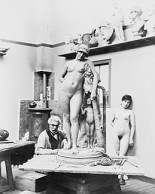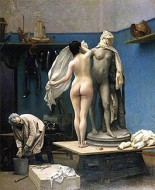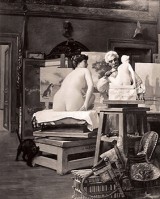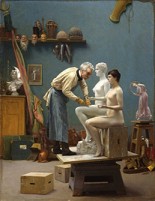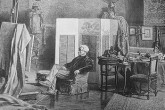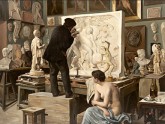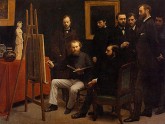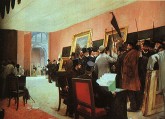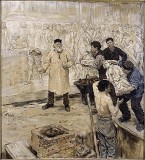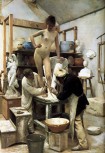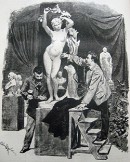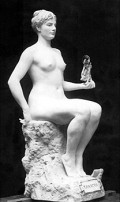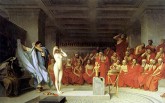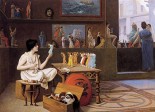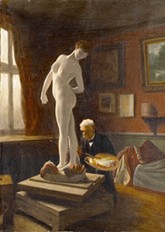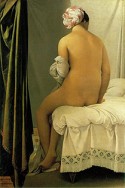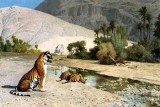The browser will either open the file, download it, or display a dialog.
Between 1886 and 1902, during the period before his death in 1904, Jean-Léon Gérôme (b. 1824) produced a group of painted and photographic self-portraits depicting himself at work in his sculpture studio. He began these works eight years after he made his sculptural debut at the Universal Exposition of 1878, following a long and successful career as a painter of Orientalist and Neo-Grec works.[1] The first images are a group of six photographs for which he and his model, Emma, posed before the camera of Louis Bonnard alongside the clay maquette for Omphale, the sculpture he would exhibit at the Salon of 1887 (fig. 1).[2] Since these were presumably produced at Gérôme's behest, they are considered here as a form of collaborative self-portrait. The earliest painting in the cluster—The End of the Sitting (fig. 2)—dates from the same year as the Bonnard photographs and may have originated in one of them.[3] One of the last of the paintings (fig. 3), dated 1902, is now lost, but, according to Gerald Ackerman's catalogue raisonné, it was closely based on a photograph.[4]
Although there is no indication that these works were planned as a series, their similar iconography allows them to be considered as a group. Almost invariably, the works include a limited repertoire of figures: Gérôme shows himself clad in a smock or apron, as he works on a clay or plaster maquette of a nude female figure, usually classical in subject, while the nude model is posed in a manner that invites the viewer to compare her body and the sculpture. Gérôme's repeated return to this theme is especially striking since, although he painted other self-portraits, he never depicted himself at work in his painting studio. What was at stake in his repetition of this topos?
Almost all the paintings in the group were based on photographs to one degree or another, and the conjunction of artist, live model, and sculpture in a painted self-portrait based on a photograph opens up a complex of themes: the relationship of artist and model, of model and art work, and of artist and work; and the interconnections between painting and sculpture and between painting and photography. Recent examinations of the self-portraits have focused on the issues raised by the juxtaposition of sculpture and model and the paintings' relationship to photography. Victor I. Stoichita and Philip Hardie have examined them in terms of Ovid's narrative of the myth of Pygmalion, the ancient Greek sculptor who fell so deeply in love with his own statue of a woman that Aphrodite turned the ivory into living flesh. Gérôme himself took up the narrative of Pygmalion in painting and sculpture, and indeed one of his paintings of the myth was incorporated into what is probably the best known of the self-portraits, Working in Marble or The Artist Sculpting "Tanagra" (fig. 4).[5] Stoichita, framing Pygmalion's sculpture as the prototypical simulacrum, considers Gérôme's reliance on photography in this group as a critical step in a historical trajectory of Ovid's myth that extends from medieval illuminations of The Romance of the Rose to Hitchcock's Vertigo.[6] Philip Hardie examines the self-portraits as Gérôme's response to photography's reproductive capacities and the challenges they presented to his sense of painting's power to capture the presence of the original.[7] In contrast to these readings emphasizing the importance of photography, Sunanda Sanyal has argued that the self-portraits comprise an allegorical summation of Gérôme's understanding of the nature of representation that was provoked by the rise of modernist painting.[8]
This paper will turn from questions of representation to explore Gérôme's self-portraits as a case study in professional identity, masculinity, and the "anxiety of lateness." It will suggest that as his career drew to a close Gérôme was troubled by persistent doubts and uncertainties about his standing and his legacy—misgivings provoked both by his advancing age and by the decline of the institutional structures and values on which he had built his career. While as a group the self-portraits may be seen as a "summation," when examined as a sequence produced over approximately a decade and a half, they reveal not only his aspirations but also his anxieties.
As a genre, self-portraiture seems to promise a uniquely privileged view of the artist. T. J. Clark put it vividly, "We are being shown someone seeing the thing he or she understands best, or at least, in a way nobody else could."[9] This is particularly true when the artist works from a mirror—when the painting presents the artist looking outwards as though confronting himself (or herself) in the reflection and places the viewer in the artist's chair, as it were.[10] But Gérôme relinquished the intimacy of the canvas as mirror and framed the viewer as a studio visitor. Relying on photographs to establish a more detached perspective, he supplants the illusion of accessibility with an assertion of his prowess by displaying his virtuosity in two media. The persistent presence of the nude female model, who becomes "nature" to his "culture" as well as an object for our gaze, seems to underscore his mastery.[11] This is perhaps seen most clearly in The Artist Sculpting "Tanagra," which Linda Nochlin has described as relying on the artist-and-his-model-in-the-studio topos to perpetuate an ideology of gender and power.[12] Thus, Gérôme's self-portraits are ostensibly a celebration of his masculine prowess, pointedly suggesting that as he entered his seventh decade (he was 63 when he painted the first), his artistic powers were expanding and growing, rather than diminishing.
Self-portraiture also may function as a means of self-promotion, and Gérôme's reiteration of an iconography of mastery over such an extended period might seem to have been a means of shaping his public persona.[13] The self-portraits were not exhibited at the Salon, however. Only two were accessible to the public: one was reproduced as a print by Goupil et Cie, and The Artist Sculpting "Tanagra" was displayed prominently in Gérôme's painting studio, where it would have been seen by visitors and by viewers of published photographs of the artist.[14] The self-portraits appear, therefore, to have been directed less to the broad public than to a more personal and private audience.
Gérôme's repeated assertion of his expanding powers seems excessive, suggesting an almost obsessive need to remind himself of his mastery. Should Gérôme's turn to sculpture be seen as symptomatic of a mid-life crisis of masculinity? Are the self-portraits assertions of his doctrines or a form of masculine overcompensation? I will argue that as Gérôme entered the endgame—as his career drew to a close—he became increasingly troubled about his legacy and suffered from what I would call an anxiety of lateness. The self-portraits were a way of confronting and managing this disquiet.
"Late Style" and "Old Age Style" have been employed by historians and critics of various art forms to designate the particular formal characteristics that mark an artist's production in his or her final years.[15] Often an artist's "late style" may be seen as the final consummation of decades of experience, a period when the technical skills honed over a lifetime triumph over bodily failure. Turning this on its head, however, Edward Said has proposed that in some instances "artistic lateness" may be seen "not as harmony and resolution but as intransigence, difficulty, and unresolved contradiction."[16] What, he asks, if lateness is characterized by "nonharmonious, nonserene tension, and above all, a sort of deliberately unproductive productiveness going against"?
The anxiety of lateness that emerges in Gérôme's self-portraits is perhaps closest to Said's notion of intransigent dissonance. Stylistically, these paintings are not distinct from his earlier works, though in formal terms, Gérôme's entire sculptural production might be considered as an instance of "late style," since he took up the medium in his mid-fifties.[17] Close readings of the self-portraits suggest that they were initially informed by the ambitions that fueled his turn to sculpture, and that later they were shaped by his growing awareness that the academic structures with which he was associated were giving way to new institutional frameworks and avant-garde styles. As a series, they suggest an on-going effort to come to terms with the close of his career and a preoccupation with securing his legacy.
My notion of an "anxiety of lateness" owes a debt, of course, to Harold Bloom's influential theory of the "anxiety of influence." Bloom maintains that poetic originality is based on the poet's conflicted relationship with—and misreading of the work of—a significant predecessor, and has developed his theory in subtle and complex ways to include six "revisionary ratios" or specific forms that the misreading might take.[18] My thought is much simpler: that an artist approaching the close of his career may worry that he and the style with which he has been associated will be displaced by those who come later, and that his accomplishments will disappear from the museum and the historical record. Certainly an "anxiety of lateness" might take a variety of forms. For Gérôme it took the form of overcompensation, a self-presentation in which traits the subject finds unacceptable are suppressed and those the subject finds desirable are exaggerated.[19] If the self-portraits are an allegorization of his philosophy of representation, as Sanyal has argued, and an assertion of a masculinist ideology, as Nochlin has argued, the overwrought and obsessive character of the group of self-portraits also points towards persistent underlying misgivings. Returning again and again to the theme, Gérôme reveals the tenacity of his unabated doubts and uncertainties about his future standing and prestige.
Gérôme's Self-Portraits and His Public Persona
Although the self-portraits do not replicate a single composition, their commonalities allow them to be considered as a group: the setting (the sculpture studio), the figures (Gérôme and his model), the dress (he clad in a smock and she nude), and the shared undertaking (work on a figure for which the model has posed). The variations in the images are significant in ways I will investigate below, but I want first to examine some of the issues raised by their common elements and to explore how Gérôme's self-fashioning in these works differed from the image of him that appeared in the press.
Gérôme's public persona, as constructed through published images of him, was fundamentally at odds with the self-image he developed in his self-portraits. A wood engraving, undoubtedly based on an anonymous photograph, that appeared in the popular weekly L'Illustration in 1886 is representative (fig. 5).[20] It shows the artist seated in his painting studio, contemplating a painting set on an easel that is turned away from the viewer. He wears a soft jacket over a vest and shirt with a high collar and tie, pants, and slippers. Behind him, the studio is crowded with the paraphernalia seen in his paintings: two sets of armor—one of which appears to be Japanese, while the other may be Ottoman in origin; an Oriental screen and carpets; and, on a small table, a jumble of objects which includes a military-style cap and some small sculpture. Comparable images appeared in other journals, including the English language press, such as The Century Magazine, which published Fanny Field Hering's profile of the artist in 1889.[21] In short, if Gérôme's self-portraits frame him as a sculptor working within the classical tradition, his public persona was that of an Orientalist painter.
According to Ackerman, Gérôme's three-dimensional work grew out of the clay studies he produced in preparation for his paintings and his dissatisfaction with the sculptured copies of his painted figures produced by other artists—notably Alexandre Falguière—for Goupil et Cie.[22] Gérôme's self-portraits suggest that once he started to exhibit sculptural work, however, more was at stake. He was not the only artist to work in both media—Falguière regularly exhibited paintings at the Salon.[23] Exhibiting sculpture as well as painting clearly expanded Gérôme's professional profile, but it also complicated his persona.
Something of what was at stake for him is revealed by his listing in the exhibition catalogue for the Universal Exposition of 1878 at which he made his sculptural debut with The Gladiators, which depicts an aging murmillo standing victorious over a defeated younger rival. Gérôme was listed twice: once under painting and once under sculpture.[24] The painting entry listed all the awards he had accumulated in a painting career distinguished by official honors and appointments.[25] He had received his first medal at the Salon of 1847, additional awards in 1848 and 1855, and was named to the Legion d'Honneur in 1855. In 1864 he became a professor at the Ecole des Beaux-Arts, and the following year he was made a member of the Institut de France. In 1867, he became an officer in the Legion d'Honneur, and—after receiving medals at the international expositions of 1867, 1874, and 1878—was made a Commander in 1878. In contrast, the entry in the catalogue's sculpture section—although it directed the reader to the painting section—listed him simply as a student of Delaroche.
As a painter, Gérôme enjoyed prestige and repute by the 1880s that established his masculine mastery within the French artistic arena, but working in sculpture returned him to the bottom of the professional hierarchy. As far as the public was concerned, Gérôme was a novice sculptor. At a moment in his career when he might have been expected to play the role of an elder statesman within the artistic community, he returned to the arena to compete against younger artists who were at the beginning their careers. Through the final decades of the century, as he accumulated additional awards for the sculptures he sent to the Salon, he continued to remount the hierarchy established by official honors.
In a sense, Gérôme's accumulation of a new series of awards and commissions signified both his continued artistic mastery and his personal investment in such official structures. But throughout the 1880s, he also watched as the state institutions on which he had built his career welcomed artists whose work he considered inferior: members of the avant-garde and women.[26] As the conservative phase of the Third Republic gave way to a more liberal government, Edouard Manet was awarded the Legion d'Honneur in 1881 and given a posthumous exhibition at the Ecole des Beaux-Arts in 1884. In 1890, Olympia entered the state collections through a public subscription, and in the same decade, the Caillebotte bequest was accepted into the Musée du Luxembourg.[27] Gérôme famously protested these events which marked the rise of what he considered moral and intellectual disorder.[28] He saw himself as a combatant defending aesthetic standards, as he wrote to Fanny Field Hering:
I claim the honor of having waged war against these tendencies and shall continue to combat them, but what can one do against the current? ...I must say that many painters of the modern school, the impressionists, the plein-air-istes, the independents, etc., are more or less fumistes [jokers],[29] some of them humbugs and some ignorant as carps...To-day when one walks through the halls of the Exposition of Paris, one is struck first by the great number of works produced—works which often have not cost their authors any great pains in any respect, as to either subject or execution. The commonplace is in honor, and poetry has fled to the skies. Will she ever descend again?[30]
Concurrently, issues of gender in artistic production were taking on new saliency as increasing numbers of women entered the profession.[31] Several private teaching studios in Paris accommodated women, most notably those of the Académie Julian, which by 1890 would include four women's studios.[32] If women continued to be excluded from the Ecole des Beaux-Arts, their growing presence in the art world could not be avoided, and in 1889 the issue of women's entry into the Ecole was officially put on the table, thanks to the effort of the Union des Femmes Peintres et Sculpteurs at the Congrès International des Oeuvres et Institutions Féminines at the Universal Exposition. Gérôme was appointed to a committee at the Ecole to review this issue; his response will be taken up in more detail below.
The point I want to make here is that as his career drew to a close, Gérôme's reputation was destabilized because of both his own initiatives in a new medium and institutional changes over which he had no control. His self-portraits were produced at a period when his career was split between painting and sculpture, when his public persona was divided between novice and master, when the aesthetic values to which he had committed his career were giving way in official exhibitions to work he regarded as vulgar and inept, and his legacy was becoming increasingly uncertain.
Taking on the persona of a sculptor, however, entailed more than exhibiting works at the Salon. Sculpture was not simply a different medium—it also engaged a different set of cultural values and patterns. That Gérôme was conscious of this is suggested by his choice of costume in his self-portraits: he repeatedly shows himself clad in a smock or in a smock and apron. While this might seem routine studio dress, it differs from the jacket which he typically wears in images of him in his painting studio, such as the one that appeared in L'Illustration. His smock also differs from the garb worn by sculptors in other fin-de-siècle images, such as Edouard Dantan's painting of his father Jean-Laurent Dantan repairing one of his well-known works (fig. 6), which shows the sculptor at work wearing a jacket.[33] Within the artistic community, suits were virtually ubiquitous, worn by the avant-garde and academics alike, as can be seen in group portraits such as Henri Fantin-Latour's Studio at Les Batignolles (fig. 7) and Henri Gervex's Meeting of the Painting Jury (fig. 8). J. C. Flugel first suggested that the sober uniformity of the dark suit, which became the conventional masculine dress following the French Revolution, signified democratic and bourgeois values in contrast to the elaborate decoration of men's clothing that had marked aristocratic supremacy in the Ançien Régime.[34] Although middle-class men in the nineteenth century relied on subtle variations in the fabric and cut of their suits to signal differences in wealth and professional orientation, Gérôme's choice of a smock places him clearly in another class.[35] This was the costume of practiciens or technicians, such as the bronze caster Eugène Gonon, whom Jean-François Raffaelli depicted in 1886 as he directed the assembly of the full-scale cast of a work by Jules Dalou (fig. 9).[36]
In her study of Jean-Baptiste Carpeaux, Anne Wagner notes that prior to the nineteenth century the profession of sculpture had been set apart from that of painting by its physical demands, but in the nineteenth century it was "splintered" between the practiciens who realized the work of art, and the artist who conceived it.[37] Throughout the first part of the century, most portraits of sculptors, as Wagner demonstrates, distanced the sculptor from the physical labor of production, preferring to focus on the moment of inspiration, the genesis of the idea behind the work. As an example, she points to images showing sculptors seated in a contemplative pose, their heads on their hands as they meditate on the work to come. In contrast, portraits of sculptors from the last quarter of the century—like that of Jean-Laurent Dantan—show the artist at work and engaged with the physical aspects of sculptural production. These representations suggest that the sculptor's public persona was shifting from the originator of an idea to the maker of an object—a process that in the early twentieth century would culminate in the revival of direct sculpture.[38] But this is not to say that in the late nineteenth century the sculptor was elided with the laborer: Dantan, as noted above, wears a jacket. It is rumpled and covered with plaster dust, which would set him apart from the bourgeois comme il faut (for whom cleanliness was an important signifier of class), but the jacket also clearly separates him from men like Gonon, who labored to produce the final works and whose engagement with physical rather than mental labor is signaled by their dress.[39] Sculptors may well have donned some sort of protective garb in the privacy of their studios—and certainly there are images of sculptors in smocks—but in staging their public personas, they typically wore suits and projected a bourgeois identity.
Gérôme, like other fin-de-siècle sculptors, completed the preliminary clay and plaster versions of his works and turned these over to practiciens who realized the finished marbles.[40] In adopting the smock and apron in his self-portraits, however, he insists on his role in the material aspects of sculptural production and asserts a working-class identity. Perhaps, as the son of a goldsmith with a notoriously strong work ethic, he highly valued the physical aspects of sculptural process, but I would suggest that—as a painter-turned-sculptor and a novice in the medium—he adopted the smock in his self-portraits to underscore that he, rather than practiciens, was both the conceptual and physical source of his works. Additionally, the smock also heightened his masculinity. As Amelia Jones has argued, nineteenth-century artists often adopted working-class dress to distance themselves from the femininity associated with bourgeois domesticity.[41] In his self-portraits, Gérôme's smock thus helps to strengthen the masculine image that his turn from painting to sculpture had undermined.
Gérôme's Self-Portraits and Private Anxieties
For Gérôme, the production and exhibition of sculpture marked a shift that simultaneously expanded, complicated, and destabilized his public persona; it was a maneuver that necessitated careful negotiation and constant reassessment. The self-portraits, which continued from 1886 until 1902, two years before his death, served this process.
The schema they would follow was established in the photographs Gérôme produced in collaboration with Louis Bonnard in 1886. The series of six photographs is set in his sculpture studio: five show the artist and his model posing with Omphale, and the final image shows only the sculpture. The photographs of artist, model, and sculpture are taken from a variety of angles. In the image showing a frontal view (fig. 1), the center is dominated by the work, which represents the Lydian queen to whom Hercules was enslaved. At the base of the sculpture, to the viewer's right, Gérôme's tools—calipers, sponge, and scrapers—are spread out; behind them, the model poses before the camera as she would for the artist. To the left of the sculpture, the artist himself is seated, leaning forward against the sculpture stand. The resemblance between sculpture and model in this image, which Ackerman characterized as "uncanny," is an unmistakable invitation to the viewer to compare them, and the artist's confrontational gaze suggests that he awaits the viewer's response to the comparison he and Bonnard have staged.
For viewers in 1886, the striking resemblance of model and sculpture would have implicitly raised an issue relating to Gérôme's process: that of the life-cast. Throughout the nineteenth century, the possibility that a sculpture had been produced by this method was raised periodically in public discourse.[42] In 1847—the year of Gérôme's Salon debut—the rumor that Auguste Clésinger's Woman Bitten by a Snake had been cast from the nude body of the courtesan Appolonie-Aglaé Sabatier had circulated widely and contributed to the work's succès de scandale.[43] This controversy was followed by other less memorable but equally fraught debates: as realism displaced academic classicism in sculpture, the charge that an artist had relied on a cast surfaced more frequently.[44] In 1877, Belgian critics had suggested that Rodin's The Age of Bronze was based on a cast. Rodin considered the allegation a professional affront, and before he submitted the work to the jury of the Salon de la Société Nationale des Beaux-Arts in Paris, he hired Gaudenzio Marconi, well known for his études de nature, to photograph his model, Auguste Neyt, and provide proof that his sculpture was not a cast.[45] The debate became particularly heated in 1881, when Salon critics raised suspicions about works by Jean Désirée Ringel d'Illzach and Jean Carriès.[46]
Although sculptors routinely took molds from their models, to base a sculpture on a cast was problematic for several reasons. As Georges Didi-Huberman has argued, the process not only alluded to its origins in the death mask, but because it seemed mechanical and produced a direct record of the imperfections of the living body, it also subverted the notion of the beau idéal, which was fundamental to classical theory and the academic tradition.[47] Gérôme was not averse to relying on photography for his paintings—which, like cast making, was widely considered a mechanical process—and was devoted to an ideal of truth that was photographic in its reliance on detail, but perhaps he feared that Salon critics might suggest that Omphale, which was the first nude he exhibited, was produced in this manner. As a painter-turned-sculptor, he may have been sensitive to the possibility that he might be accused of taking shortcuts. The calipers laid out in the foreground of the Bonnard photograph point towards his reliance on the technique he was taught by Emanuel Frémiet that entailed careful measurement of model and sculpture.[48] Were the photographs intended to foreclose speculation?
Body casts also fascinated critics and the public because of the implicit eroticism of the process. This was foregrounded in 1887 by Joseph-Edouard Dantan's A Casting from Life (fig. 10).[49] Dantan's painting depicts two practiciens gingerly removing a hardened cast from the leg of a nude model who watches impassively. The bowls of plaster in the foreground and the nude bust hanging on the wall behind the group are reminders that the initial steps in the process would have entailed the men's smoothing the wet plaster over the model's flesh. Their access to her nude body gives the process a distinctly erotic dimension.
Certainly in the popular imagination, a sculptor's access to the nude model—whether or not he relied on a life cast—carried high connotations of eroticism. Consider Adrien Marie's image published in the La Vie moderne in 1880 that shows Falguière at work on his sculpture of Eve (fig. 11). Intent on his work, the artist is oblivious to the response of the sculptural figure, which reacts to his touch as though she were a live woman. The conceit of the living sculpture—the Pygmalion topos—serves here to underline the erotic possibilities of the artist/model transaction. In the popular press, the sculptor's engagement with the model was presumed to be sexual—a cliché that Rodin integrated effectively into his public persona.[50] Gérôme includes the desirable nude female model and establishes a male/female polarity, but seems to have preferred to disassociate himself from the notion that his process entailed an erotic transaction: seated across the room from his model, he seems more responsive to the viewer than to her.
When Omphale was exhibited at the Salon, critics focused on the sculpture's archeological character and contrasted it with Falguière's Diana, shown in the same gallery. Writing in La Revue des Deux Mondes, Georges Lafenestre compared the supple liveliness of Falguière's nude, whose "haughty modesty" he thought gave it a modern air, with the archaic qualities of Gérôme's work: "The artist wanted to be 'Greek,' but thoroughly in this instance, less by the precise exterior details than by the totality of the work and by the spirit which animates it: he has succeeded exceptionally well."[51] Roger Ballu, writing for L'Illustration, also contrasted Gérôme's interest in archeological detail with Falguière's treatment of living, palpitating flesh: if Falguière was a "sculptor painter," Gérôme was a "painter sculptor."[52] The remark implied that Gérôme reduced painted figures to lifeless stone, while Falguière brought stone to life. Such remarks might have annoyed Gérôme, who could be impatient with critics.[53]
Gérôme directly engaged the issue of his double career and the relationship between painting and sculpture in The End of the Sitting (fig. 2), painted the year before the sculpture was seen at the Salon. Leaning over a bucket in which he cleans his tools, he again asserts his role as the active producer of the work. Simultaneously, he stands in for the viewer, watching as Emma covers the clay sculpture with wet rags to preserve its malleability for a future sitting. Like Bonnard's photograph, the painting offers a comparison between the model and the sculpture—but here it is the differences between the two that are highlighted. The warm pink flesh of the model, seen from behind, is set against the damp gray clay of the sculpture, which faces the viewer. The heavy shrouding of the heads of the sculptural forms underlines their inanimate insentience. In this contest between front and back, lively body and inert sculpture, art and nature, art—sculpture—seems to lose. Did Gérôme fear that in some sense his turn to sculpture was proving a failure?
And what of the rose set in the foreground on the sculpture stand? Its red brilliance jumps out of the gray and blue tonality of the painting, and its fragile petals seem out of place within an atelier filled with clay dust, but it serves as a double signifier: of art and of sex. On the one hand, flowers are familiar signifiers of feminine sexuality—and the placement of the rose at Emma's feet here points towards the artist's access to the nude female body. But, as in the photographs by Bonnard, Gérôme himself withdraws from direct contact with the model. While the rose reminds the viewer of the erotic connotations of the artist/model transaction that fueled the popular imagination, Gérôme seems to distance himself from this possibility. On the other hand, the rose's incongruity also reminds viewers that they are looking at a painting. If Emma's pink flesh and the red petals of the rose are more visually compelling than the clay figure of Omphale, they are, after all,c no more "real" than the sculpture—all are painted. Beyond asserting Gérôme's double identity as painter and sculptor, the self-portrait, which stages a contest between media and replays the paragone of the Renaissance, suggests that for Gérôme the two media were in tension.[54] Here, at least, the award goes to painting: Gérôme's sculpture remains merely a lifeless lump of clay, while his painting brings to life the model's fleshy body and the delicate petals of the rose.
Gérôme resolved the contest between painting and sculpture and contributed to a charged debate about polychromed sculpture by combining the two media in Tanagra (fig. 12), exhibited in the Salon of 1890.[55] In this and later works, he tinted the marble to approximate flesh, though the color has since disappeared. In the nineteenth century, sculptural polychromy had ardent supporters, who cited antique precedents, and equally zealous critics, who found it vulgar at best.[56] In his commitment to polychromy, Gérôme aligned himself with recent archeological discoveries: Tanagra, now in the Musée d'Orsay, represents the personification of the ancient village where, in the 1870s, archaeologists had discovered a cache of Hellenistic terra cotta figurines that were glazed with color. The response to Gérôme's work was, predictably, mixed. Other sculptors followed his example and two years later, when he exhibited Bellona, which was made of bronze, ivory and precious stone, Edmond Pottier commented in a Salon review for the Gazette des Beaux-Arts that the debut of Tanagra had marked "a new era in contemporary sculpture."[57] Others, however, condemned the practice: Gustave Geffroy likened polychromed sculpture to waxworks and complained: "It is the opposite of statuary...It is the repudiation of art."[58] Despite the controversy, Gérôme was unwavering and must have considered polychromy as central to his contribution to modern sculpture: though he had—with great politesse—rebuffed the state's efforts to buy Omphale, he accepted the government's offer to purchase Tanagra.[59]
The Artist Sculpting "Tanagra," of 1890 (fig. 4), which photographs from the period show hanging in his studio, marks this resolution of the paragone—albeit obliquely—and re-explores the problem of the relationship of art and sexuality. Although Gérôme does not here directly depict the introduction of paint, the image engages two sculptural paradigms: art as the imitation of reality—the desire to make sculpture as lifelike as possible, which the application of color enhanced; and art as the perpetuation of an ideal—a notion that looks back to antique traditions as perpetuated in the practice of the Ecole des Beaux-Arts.[60]
In contrast to the 1886 self-portrait, the artist has moved from margins to the center, where he hovers intently over his sculpture and the model. The studio is now crowded with other works by Gérôme: a bust of Selene, the Hoop Dancer, and a version of his painting of Pygmalion and Galatea. [61] The sculptures are presented as inquisitive observers of the artist and model. To the left, Selene, the virginal moon goddess, turns towards them; while at the right, the dancer cranes her neck for a better view. Hanging from a shelf are a series of masks, leering and smirking. The sculptures that inhabit Gérôme's studio, in other words, are more animated than the artist and model. The familiar conceit of the living sculpture here embodies one aspect of his ambitions: that art might not only replicate, but be confused with nature.
This aspect of Gérôme's sculptural ambitions had something in common with the notion of the uncanny (that Freud would develop in 1919) and with the ancient myth of Pygmalion and Galatea.[62] As though to underline this, he included in the self-portrait one of his three painted versions of Pygmalion and Galatea—a theme he would also take up in sculpture in 1892.[63] It has been argued that Gérôme's treatment of the myth in both painting and sculpture foregrounds the physicality of the artist's desire and his erotic engagement with his model.[64] But it needs to be remembered Pygmalion's desire was focused not on a flesh and blood woman, not on a model, but on his sculpture, the physical embodiment of his own imagined ideal. The sculpture, in the analysis of Victor Stoichita, is a simulacrum designed to protect the artist from the disgust he felt for live women.[65] Or, as Alexandra Wettlaufer has perceptively argued in her work on Anne-Louis Girodet's treatment of the topos, the Pygmalion narrative is fundamentally an autoerotic allegory of creation: since there is no live woman at all, it is in some respects the ultimate misogynistic notion of artistic creation.[66]
In a closer view of Gérôme's self-portrait, his rendering of the model and the work of art reasserts the importance of the artist's imagined ideal and the difference between art and nature. Although sculpture and model are deliberately aligned to facilitate a comparison—and seem remarkably similar initially—a careful study of the two profiles shows subtle but significant differences. In the sculpture, the line from forehead to nose is straighter and the chin is a bit lighter; in the flesh, Emma's silhouette reveals the retroussé nose—often attributed to the Parisienne—and a slightly receding chin. In other words, Gérôme's sculpture is closer to the antique ideal. The self-portrait asserts the limits of his devotion to nature: in his oeuvre, the live model—la belle nature—serves merely as a place holder for le beau idéal—the perfected figure whose source was the artist's imagination and whose roots are in antique forms.[67] The self-portrait, in other words, asserts that despite Gérôme's striking ability to mimic nature, he worked within and was loyal to academic tradition maintained by the Ecole des Beaux-Arts.
Of course, in showing himself at work, reaching towards the thigh of the sculpture that simulates the nude model, he broaches the distance between artist and model that he had maintained in earlier representations. He reminded viewers that his practice entailed access to the nude female body, an access which in the popular imagination inevitably collapsed into a sexual encounter—as evidenced by the drawing of Falguière published in La Vie moderne examined earlier. Certainly, Gérôme understood very well the erotic potential of a nude, whether live or in representation: it had been one of his stocks-in-trade throughout his career. He had also thematized the dynamic between female nude and male audience in paintings such as Phryne before the Areopagus (fig. 13).[68] The painting depicts the trial of the Greek courtesan and model for Praxiteles and Apelles who had been accused of impiety. Standing nude before the judges, Phryne hides her face in shame, as the men ogle her, their faces mirroring their lust.[69] The sages, whose age should render them wise, are reduced to dirty old men, and their response becomes the spectacle. The gendering of the image suggests the power of the naked female body to overwhelm masculine self-possession.
Gérôme seems to have been very aware that men would become fools for a beautiful female body, but in his self-portrait of 1890, if the presence of the nude female model underlines his masculinity, the lecherous stares of the judges in the trial of Phryne are transferred to the masks that hang from the shelf behind him. Their leers and smirks become the signifiers of a masculine loss of control, a response that contrasts with the artist's preternatural restraint. Rather than denying or suppressing the erotic gaze, then, Gérôme's image displaces it, separating it from the aesthetic gaze, which he—the artist—embodies. His masculinity is distinguished by self-discipline and self-control.
In the broader historical context, Gérôme's emphasis on the artist's composure when confronted by a woman in the studio resonates with a question raised by contemporary debates about women's entry into the Ecole des Beaux-Arts and the artistic profession. Female models had been introduced into the Ecole des Beaux-Arts in the Second Empire, and though they were associated with commotions in the studios, the incidents seem to have been tolerated by the administration.[70] By the Third Republic, however, the growing presence of women artists created a new type of disturbance. In October 1883, Gérôme's studio at the Ecole had been disrupted when an incident involving a woman artist resulted in the suspension of several students. During these decades it became the practice for models, both male and female, to gather on Monday mornings outside the entrance to the Ecole on the rue Bonaparte.[71] Most came hoping for work at the Ecole, but other artists as well used the "market" to hire models. The working-class women who posed in the Ecole routinely endured harassment from students, but one Monday, Gérôme's students tormented a woman whom they mistakenly thought was a model but who was in fact an artist in search of someone to pose.[72] When students in other Ecole ateliers came to her defense, a fracas ensued. Although the woman preferred to let the incident pass without official complaint, the quarrel led to several of Gérôme's students being sanctioned and barred from his studio for six months. By the 1880s, then, the presence of women artists promised to be disruptive in a way that female models had not.
In 1890, the issue of women's entry to the Ecole des Beaux-Arts was officially taken up when the leaders of the Union des Femmes Peintres et Sculpteurs, who had raised the question the previous year at the Universal Exposition, met with a committee from the Ecole—Gérôme was a member—to introduce a petition in support women's admission.[73] The committee's discussion of the issues raised by this possibility would become notorious. In her memoirs, Virginie Elodie Demont-Breton vividly described the scene when she and Héléna Hébert (Mme. Léon Bertaux) presented their case:
Charles Garnier cried vehemently that it was impossible, that to put young men and women under the same roof was to mix powder and flint and would produce an explosion in which art would be entirely dashed to pieces. [Eugène] Guillaume, usually so composed, cried: "What are you, a street kid? When an artist works, does he dream of anything except the study that excites and worries him? In such a school, where legitimate progress is made, there would no longer be men and women, only artists animated by pure and noble ambition!"
Garnier replied, "Maybe you, the great sculptor, are made of marble or wood like your work, but as for me, if at twenty I had seen a sweet young face next to my easel, my drawing would have gone to the devil! Oh, Guillaume you are not a man!"
To which Guillaume replied, "Oh, Garnier, you are not an artist!"[74]
As Demont-Breton asked, which was the worse insult? Gérôme was opposed to women's admission, and his contribution to the debate was to deflect the controversy by raising the issue of the budget—the kind of bureaucratic tactic that would effectively delay women's admission until 1897. Nonetheless, the question of whether one were "a man or an artist" resonates within The Artist Sculpting "Tanagra": the self-portrait of 1890 represents Gérôme's resolution of not only the conflicts between painting and sculpture and between art and nature, but also between the erotic and the aesthetic gaze. It encapsulates, in short, his ego ideal: he is master of himself, of his art, and of nature. Small wonder he hung it in his studio.
But if the 1890 self-portrait represents an idealized self, his underlying anxieties surface in a painting of 1893, Painting Breathes Life into Sculpture (Sculpturae vitam insufflat pictura) (fig. 14).[75] Emmanuelle Héran has called the work a pictorial manifesto which makes explicit Gérôme's intent to use painting to renew sculpture.[76] While certainly the title and the primary figure evoke an ideal of synergy between painting and sculpture, the image itself incorporates a series of attendant issues which the title passes over: the relationship of art and commerce, the differences between the high and the decorative arts, and the gender of the artist. Although the work is not a self-portrait, it is pervaded by Gérôme's presence and his anxieties.
The painting depicts a scene in Tanagra, the ancient Greek city personified in Gérôme's sculpture of 1890. By the 1880s, the figurines discovered at this site in the 1870s had become a fashionable and costly ornament to well-appointed Parisian drawing rooms. Pastiches and fakes produced by contemporary artists soon proliferated.[77] Gérôme represents an ancient studio and shop for the production and sale of the small sculptures. In the left foreground, a young woman sits cross-legged on a stool before a table on which a series of identical ceramic figurines are arrayed: she is painting them brilliant colors—red, blue, and yellow. In the right background, a saleswoman stands behind a counter with a display of completed figurines that are admired by two women customers dressed in the kind of hat and drapery depicted in Tanagra figures.
The two halves of the composition clearly invoke the relationship between the studio and the market place, bringing together production and consumption in a manner quite distinct from Gérôme's self-portraits, in which the focus is restricted to the studio and issues of production. The form of artistic production depicted here is also distinct from that shown in the self-portraits, since the small figurines arrayed on the table are mass-produced casts from a single mold, unlike the monumental sculpture of Tanagra, which is included in the background. Color serves not to heighten the figures' verisimilitude, but to decorate them and render each one a unique commodity. The subject here is not the production of sculpture—high art—but of marketable trinkets—decorative art.
This rendering of Tanagra figurines is consistent with contemporary criticism. Henri Lechat, writing for Gazette des Beaux-Arts in 1893, described them as charming but modest figures that conveyed a graceful sense of day-to-day life, especially feminine life, in antiquity. He characterized the coroplaste, who produced them, as a humble workman who would never have been considered an artist by the ancients and noted that the Greek rhetorician Isocrates, seeking a witty comparison to strike his audience, had asked, "Who, for example would dare to compare Phidias to a coroplaste?"[78]
In Painting Breathes Life into Sculpture, the completely feminine cast of characters in Gérôme's painting—artist, saleswoman, and customers—serves to gender production and consumption of these works. While it is, in fact, unlikely that the original artists were female (and Lechat referred to them as male), the gender of the craftswomen in Gérôme's painting resonates with French debates in the 1890s about the capacities of women artists.[79] Though they were excluded from the Ecole des Beaux-Arts, women had long been admitted to the Ecole Nationale des Arts Décoratifs, since the decorative arts were widely considered an appropriate field for what were believed to be their distinctly lesser capabilities. Arguably, then, Gérôme here presents a statement about the suitable arena for women artists: they should be relegated to the production and decoration of charming bibelots bound for the market and private interiors, rather than the Salon and the museum.
But if the painting explicitly evokes his ideas about women's inferior potential, it also hints at his anxieties about his own position.[80] The space in which the craftswoman works is filled with Gérôme's own work: his sculptures are arrayed on the shelves behind her and Tanagra is seen in profile, against a wall perpendicular to the sales counter.[81] Indeed, the ceramic figurines decorated by the young craftswoman are Gérôme's Hoop Dancer, a pastiche of a Tanagra figurine that he set in the outstretched hand of Tanagra.
Gérôme was fond of witty visual and verbal plays that established intertextualities within his oeuvre—as in The Artist Sculpting "Tanagra"—but here the presence of his works suggests a fear that his own artistic persona had been subverted and feminized. The issue seems to be his own engagement with the production of trinkets for the market. Reproductions of Gérôme's oeuvre, both painting and sculpture, had been widely marketed since 1859.[82] His paintings were routinely copied as photographs, prints and, later, photogravures sold by Goupil et Cie, the dealer and publisher which established a worldwide trade in reproductions. As early as 1868—before his own turn to sculptural production—the figure of Phryne had been reproduced in an edition of statuettes sculpted by Falguière and marketed by Goupil. Gérôme's personal association with Adolphe Goupil was cemented by his marriage in 1863 to the publisher's daughter. His direct engagement with the production of small scale sculptural reproductions began when he painted plaster casts of the Hoop Dancer in 1890 for friends: the following year the figure was issued in a bronze edition.[83]
If reproductions of his works contributed to his wealth, critics had lambasted his engagement with this practice. In 1867, Emile Zola had argued that Gérôme's paintings were not art, but a form of fashionable merchandise:
Evidently, M. Gérôme works for the Goupil enterprise; he produces a painting in order for the painting to be reproduced by photograph and engraving and to be sold in thousands of copies. Here the subject is everything and painting is nothing: the reproduction is worth more than the work itself. [84]
The craftswoman painting The Hoop Dancer embodies Gérôme's lesser feminine self. As the artist contemplates his legacy, she represents his fear that he will be seen as a producer of decorative bibelots—a craftsman who produced for the marketplace—rather than an artist, whose works were destined for the museum. It suggests his anxiety that he was seen as an artist in decline, that his embrace of the production of multiples of his own work had contributed to reducing his own oeuvre to decorative ornaments. This fear is evoked in a final detail: set on the floor in front of the craftswoman is a wooden crate filled with grimacing masks. The masks, bodiless heads with mouths open in howls of terror or agony will be consigned to storage in a box that is prominently marked by Gérôme's signature. Do they personify the artist's fears—or do they represent his critics? Ackerman reports that Gérôme's studio was decorated with plaster "masks" or "Oriental heads," which he used for the painting Heads of the Rebel Beys at the Mosque El Assaneyn; some of these masks were reputedly portraits of art critics.[85]
If the painting suggests that by 1893 Gérôme's anxiety of lateness was surfacing, two final self-portraits dated 1902 suggest that it intensified after the turn of the century. One, depicting Gérôme at work on The Ball Player, takes a very different approach from the earlier self-portraits, though it recalls Painting Breathes Life into Sculpture. Another, known only from a contemporary photograph, again mobilizes the iconography of the earlier self-portraits.
Gérôme Polychroming the Masks of "The Ballplayer" (fig. 15) is an unfinished work that represents the artist at work on a sculpture of a nude woman engaged in an ostensibly ancient game that was in fact invented by Gérôme.[86] The sculpture dominates the foreground: standing with legs crossed, the figure twists to look behind her as she drops balls into the open mouths of three masks that ring her feet. Below and behind the sculpture, the artist holds his palette in his left hand as he applies pigment to the masks. Here Gérôme's fusion of painting and sculpture takes center stage, linking this self-portrait to the earlier Painting Breathes Life into Sculpture. In the 1893 painting, the color applied by the craftswoman served only to differentiate the three small ceramic figures, but here it almost brings the nude to life. Although the marmoreal pallor of the figure's "flesh" is unnatural, its brown "hair" heightens the ambiguity: is this marble or a living form? The contrapposto pose and point of view amplify the sense that the figure is alive: she seems to gaze down at the artist at work.[87] The Pygmalion topos is implicit, but here it is the painter rather than the goddess who effects the transformation of sculpture into flesh. In earlier self-portraits, Gérôme juxtaposed sculpture and model to underline the similarities between them and placed himself in the role of observer, but here the sculpture/woman takes on a life of its own and assumes the role of observer.
The exaggerated contrapposto of the pose of the sculpture/woman heightens her femininity, by simultaneously exposing the line of her buttocks and her breasts. But, as usual, Gérôme remains oblivious to her charms and absorbed in his work. With a palette rather than a scraper in hand, he has reclaimed his painter's persona, and the smock and the working class identity of earlier self-portraits have been abandoned for a somber black jacket with a white shirt and necktie that mark him as the proper bourgeois. He is intent upon the masks, which in earlier works watched with lust or screamed with terror. Here Gérôme seems to confront one that has been tipped up to face him directly, while the balls that the nude woman is dropping into the open mouths of the two other masks, which face upwards, will stop their screams. Might this trio represent the critics whose voices will be silenced by the game that Gérôme invented? When The Ballplayer was exhibited at the Salon of 1902 not all critics were kind. Henry Marcel, writing for Gazette des Beaux-Arts complained that the heightened realism of Gérôme's sculpture was salacious: "Gérôme's callipygian woman—with her dimples, the creases in her back, her greasy and washed-out skin—presents the most extremely irritating illusion of a libertine display."[88]
The second self-portrait of 1902 (fig. 2), now known only through a photograph, returns to the motifs of earlier self-portraits.[89] It shows Gérôme in his smock, at work on a less-than-life-size sculpture of a nude while the model poses beside him. The model sits cross-legged with her back towards the viewer, and as she twists to her right, her profile emerges over her shoulder. Her open-legged pose would have exposed her sex to the artist, who stands to her right, but Gérôme again is intently focused on his work. The sculpture would be completed as another tinted work and may also have served as a substitute for the live model, since nudes in a similar pose appear in several of his later paintings.[90] In contrast to The Artist Sculpting "Tanagra," the studio here is filled not by Gérôme's sculpture, but by his paintings and the collection of armor and other objects that he relied on to develop his representations of antique and Orientalist themes. The work again references his double career but, like the other 1902 self-portrait, seems to integrate painting and sculpture.
The curving back and profile of the model evoke numerous nudes in Gérôme's Orientalist scenes and reference Jean-Auguste-Dominique Ingres's Bather of Valpinçon (fig. 16). Nochlin has pointed out that Ingres's nude served Gérôme as a signifier of high art and the academic tradition, and the reference indicates his desire to assimilate his own painting into that tradition.[91] But here the figure carries additional significations. Behind the model, visible to her left, an easel displays Gérôme's Thirst: Tigress and Cubs of around 1884 (fig. 17).[92] The full painting shows a seated tigress watching alertly as her two cubs drink from a stream; in the self-portrait, the cubs are hidden and only the mother is visible. The sinuous curves of the tigress's spine echo the profile of the model's back, associating the woman with the fierce watchfulness of the majestic desert cat.
The nobility of the tigress is underscored by the presence at the base of the model stand of a black domestic cat, arching its back and lifting its tail as it looks out at the viewer. In French popular culture, a black cat was a familiar and vulgar signifier of female sexuality—and here it clearly references the sexuality of the nude model, to which Gérôme remains oblivious. But in 1902, a black cat accompanying a female nude would also have conjured that most infamous of felines: the one attending Manet's Olympia. Since Gérôme had long opposed official recognition of Manet and the younger artists associated with him, it is surprising that this self-portrait references this artist. But again, this work—like the self-portrait of 1886—seems to be structured around a confrontation or choice: this time the competition is not between painting and sculpture, but between art and sex, the aesthetic and the erotic, high and low, and two artistic traditions—Ingres and Manet, the Academic and the Modernist. Gérôme aligns himself with the elevated tradition of Ingres, suggesting that it is Manet's work that should be associated with salaciously vulgar displays.
Though the conflict between the academic and the avant-garde has come to be seen in contemporary art historical discourse as a reductive oversimplification of the complexities of the multiple strains of artistic production within the Third Republic, from Gérôme's perspective, it was very much alive in his final years. He had protested the Caillebotte bequest and made known his disgust with the Impressionist display at the International Exposition of 1900; in 1904 he would protest plans for an Impressionist exhibition at the Luxembourg.[93] But he was certainly aware that the conflict would ultimately play out in the state museums. In 1890, both Olympia and Tanagra entered the Musée du Luxembourg: Tanagra through an official state purchase and Olympia through a public subscription organized by Claude Monet. Gérôme would not live to see Olympia transferred to the Louvre in 1907, but in 1902, he perhaps recognized this was likely, if not inevitable. Did he also suspect that at his death his career would not receive the kind of public tribute that had commemorated Manet's passing two decades earlier? Are his final self-portraits his admission that his turn towards sculpture had failed to revive and sustain his reputation—that despite his efforts to assert his mastery of two media, and his double virtuosity, he was destined to become—in the eyes of the twentieth century—the embodiment of a collapsed tradition?
Gérôme's anxiety of lateness was both biographical and historical. As he himself recognized, the culmination of his career coincided with a moment of historical shift: the questions and issues that he had spent his life exploring, and the skills and techniques that he had honed throughout his career, were being set aside for a different aesthetic. The classicism of Ingres and the Académie des Beaux-Arts, to which he allied himself, was being replaced by the "modernity" of Manet and the Impressionists. Gérôme's anxiety of lateness was fundamentally his resistance to his obsolescence, a grudging recognition that his vision was becoming outmoded and that his life's work would be relegated to the side galleries rather than the central spaces of the museum.
Earlier versions of this paper were presented at the annual conferences of the Association of Art Historians in London in 2008 and the Midwest Art History Society in Kansas City in 2009; I am grateful to Mary Roberts, Hannah Williams, and Simon Kelly for the opportunities to participate in their panels. This version incorporates the constructive comments of the interlocutors on both occasions; in particular I want to thank Melissa Hyde, John House, Monica Kjellman-Chapin and the anonymous reader for their questions and suggestions. At critical points in the development of the essay Anne Haas, Stephanie Schlaifer, Caterina Pierre, Richa Puri, and Lauren Janes provided invaluable assistance. At Nineteenth-Century Art Worldwide Petra ten-Doesschate Chu, Robert Alvin Adler, and Isabel Taube were generous with their editorial expertise. All translations are my own unless otherwise noted.
[1] For a survey of Gérôme's sculpture, see Gerald M. Ackerman, "Gérôme's Sculpture: The Problems of Realist Sculpture," Arts Magazine 60, no. 6 (February 1986): 82–89. On the beginning of his sculptural career, see: Gerald M. Ackerman, Jean-Léon Gérôme: Monographie revisée, catalogue raisonné mis à jour (Courbevoie/Paris: ACR Editions, 2000), 114–17. The catalogue raisonné was initially published as: Gerald M. Ackerman, The Life and Work of Jean-Léon Gérôme with a catalogue raisonné (London and New York: Sotheby's Publications, 1986), 110–16. Because the English version of the first edition is more readily available, pages for this edition will be indicated in brackets; the revised edition has not been translated from the French.
[2] Ackerman, Gérôme: Monographie revisée, 147–48 [134]. Two additional works from the series are reproduced in Victor I. Stoichita, The Pygmalion Effect: From Ovid to Hitchcock (Chicago: University of Chicago Press, 2008), 163–65. On the identity of Gérôme's model, see Ackerman, "Gérôme's Sculpture," 84, where she is identified as his mistress or his granddaughter. A different contemporary account is presented in Paul Dollfus, Modèles d'artistes (Paris: C. Marpon et E. Flammarion, 1896), 99–103. Though Dollfus's work is based on anecdotes and studio gossip, his account rings truer than those presented by Ackerman, and I follow it here.
[3] Ackerman, Gérôme: Monographie revisée, cat. no. 348, 319 [260] The sitting is for Gérôme's sculpture Omphale. Ackerman gives the title as The End of the Séance or La Fin de la séance (Fin de la séance pour Omphale). See Ackerman, Life and Work of Jean-Léon Gérôme, cat no. 348, 260. Stoichita uses End of the Sitting for Omphale. See Stoichita, Pygmalion Effect, plate 12.
[4] Ackerman, Gérôme: Monographie revisée, cat. no. 472, 354 [286–87].
[5] There are two versions of this work. One, dated 1892 by Ackerman, is now in the Haggin Museum, Stockton, California. Ackerman, Gérôme: Monographie revisée, cat. no. 419, 338 [274]. The version reproduced here is in the collection of the Dahesh Museum of Art, New York. See at the website of the museum, http://www.daheshmuseum.org/collection/detail.php?object=geromej_6, (accessed July 7, 2009). The Dahesh Museum dates the painting 1890. Ackerman dates it 1895. Ackerman, Gérôme: Monographie revisée, cat. no. 419.3, 338.
[6] Stoichita, Pygmalion Effect, 161–74. For a recent study of the interplay of painting, sculpture and photography in Gérôme's oeuvre, see Jean-François Corpataux, "Phryné, Vénus et Galatée dans l'atelier de Jean-Léon Gérôme," Artibus et Historiae 30, no. 9 (2009), 145–58.
[7] Philip Hardie, Ovid's Poetics of Illusion (Cambridge: Cambridge University Press, 2002), 206–26.
[8] Sunanda K. Sanyal, "Allegorizing Representation: Gérôme's Final Phase," Athanor, 15 (1997): 38–45.
[9] T. J. Clark, "The Look of Self-Portraiture" in Self Portrait: Renaissance to Contemporary, ed. Anthony Bond and Joanna Woodall, exh. cat. (London: National Portrait Gallery, 2005), 57–66. In addition, see T. J. Clark, "Gross David with the Swoln Cheek: An Essay on Self-Portraiture," in Rediscovering History: Culture, Politics and the Psyche, ed. Michael S. Roth (Stanford: Stanford University Press, 1994), 243–307, 482–93.
[10] Anthony Bond, "Performing the Self?" in Bond and Woodall, Self Portrait, 31–42.
[11] On the alignment of femininity with nature and masculinity with culture, see Sherry B. Ortner, "Is Female to Male as Nature is to Culture?" in Women, Culture and Society, ed. Michelle Zimbalist Rosaldo and Louise Lamphere (Stanford, CA: Stanford University Press, 1974), 68–87.
[12] Linda Nochlin, "Women, Art and Power," in Women, Art and Power and Other Essays (New York: Harper and Row, 1988), 16–18. For another important consideration of gender ideology in representations of artists and their models, see Carol Duncan, "Virility and Domination in Early Twentieth-Century Vanguard Painting," in The Aesthetics of Power: Essays in Critical Art History (Cambridge: Cambridge University Press, 1993), 81–108.
[13] Recent considerations of the use of self-portraiture for self-promotion include: Martin Postle, Mark Hallett, Tim Clayton, and S. K. Tillyard, Joshua Reynolds: The Creation of Celebrity, exh. cat. (London: Tate Publications, 2005), 73–87; Petra ten-Doesschate Chu, The Most Arrogant Man in France: Gustave Courbet and the Nineteenth-Century Media Culture (Princeton: Princeton University Press, 2007), 13, 18–19.
[14] For the print version of The End of the Sitting see Hélène Lafont-Couturier, Gérôme et Goupil: Art et enterprise, exh. cat. (Paris: Réunion des Musées Nationaux; Bordeaux: Musée Goupil, 2000), 162. For a photograph by Boussaton of Gérôme in his studio that includes this painting, see Fr. Thiebault-Sisson, "Léon-Gérôme," L'Illustration 3177, January 16, 1904, 38.
[15] The history of notions of late style is considered in Karen Painter, "On Creativity and Lateness," in Late Thoughts: Reflections on Artists and Composers at Work, ed. Karen Painter and Thomas Crow (Los Angeles: Getty Publications, 2006), 1–11. See also Kenneth Clark, The Artist Grows Old: The Rede Lecture 1970 (Cambridge: Cambridge University Press, 1972), 18.
[16] Edward W. Said, On Late Style: Music and Literature Against the Grain (New York: Pantheon Books, 2006), 6–7. My thanks to Monica Kjellman-Chapin for suggesting Said's work.
[17] The possibility that Gérôme's turn to sculpture was related to a failure of eyesight was raised soon after his death. See Marion Harry Spielman, "Jean-Léon Gérôme: 1824–1904: Recollections," Magazine of Art,28 (January 1904): 204.Ackerman rejects this notion: Ackerman, "Gérôme's Sculpture," 83.
[18] Harold Bloom, The Anxiety of Influence: A Theory of Poetry (New York: Oxford University Press, 1973).
[19] Rather than including an extended discussion of the psychoanalytic theories of overcompensation, I refer the interested reader to the literature in which it has been developed. See Sigmund Freud, "The Neuro-Psychoses of Defense," in The Standard Edition of the Complete Psychological Works, ed. James Strachey (London: Hogarth Press, 1894), 3:43–61; Anna Freud, The Ego and the Mechanisms of Defense, trans. Cecil Baines (New York: International Universities Press, 1946), 9, 51, 190. Recent work on overcompensation and self-presentation includes Roy F. Baumeister, Karen Dale, and Kristin L. Sommer, "Freudian Defense Mechanisms and Empirical Findings in Modern Social Psychology: Reaction Formation, Projection, Displacement, Undoing, Isolation, Sublimation, and Denial," Journal of Personality 66, no. 6 (December 1998): 1081–1124, esp. 1082–83, 1085–89; Roy F. Baumeister and Edward E. Jones, "When Self-Presentation is Constrained by the Target's Prior Knowledge: Consistency and Compensation," Journal of Personality and Social Psychology 36, no. 6 (June 1978): 616–18. On overcompensation and issues of masculine self-presentation, see Rob Willer, "Overdoing Gender," paper presented at the annual meeting of the American Sociological Association, Marriott Hotel, Loews Philadelphia Hotel, Philadelphia, PA, Aug 12, 2005, http://www.allacademic.com/meta/p23054_index.html, (accessed July 7, 2009).
[20] Paul Eudel, "Les ateliers des peintres: J. L. Gérôme," L'Ilustration 2251, April 17, 1886, 257.
[21] Fanny Field Hering, "Gérôme," Century Magazine 37, no. 4 (February 1889), 483–99. A similar photograph also was published in Spielman, "Jean-Léon Gérôme," 206.
[22] Ackerman, Gérôme: Monographie revisée, 114–15 [110–12].
[23] Peter Fusco and H. W. Janson, The Romantics to Rodin: French Nineteenth-Century Sculpture from North American Collections, exh. cat. (Los Angeles: Los Angeles County Museum of Art; New York: G. Braziller, 1980), 261.
[24] Paris Universal Exposition of 1878, World's Fair of 1878, Modern Art in Paris (New York: Garland Publications, 1981), reprint of Catalogue officiel: tome 1, groupe 1, oeuvres d'art, classes 1 à 5 (Paris: Imprimerie Nationale, 1878), 30, 97. Citation is to the Garland edition. A murmillo was a class of gladiator, identifiable by the distinctive helmet with a crest that resembled a fish.
[25] A chronology of significant events in Gérôme's career is provided in Lafont-Couturier Gérôme et Goupil, 164–67.
[26] On Gérôme's attitude towards the avant-garde and women, see Ackerman, Gérôme: Monographie revisée, 138, 156–58, 187–89 [128, 144, 166–67].
[27] M. Berhaut, "Le legs Caillebotte: Verités et contre vérités," Bulletin de la société de l'histoire de l'art français, 1983, 209–39.
[28] For a summary of Gérôme's opposition to Manet and the Impressionists, see Gerald Ackerman, "Thoughts on Finishing a Monograph on Gérôme," Arts Magazine 60, no. 5 (January 1986): 82.
[29] For the origin of the term and the history of fumisme, see Phillip Dennis Cate, "The Spirit of Montmartre, in The Spirit of Montmartre: Cabarets, Humor, and the Avant-Garde, 1875–1905, exh. cat. (New Brunswick, New Jersey: Jane Voorhees Zimmerli Art Museum, Rutgers, The State University, 1996), 5, 23.
[30] Hering, "Gérôme," 493.
[31] Tamar Garb, Sisters of the Brush: Women's Artistic Culture in Late Nineteenth-Century Paris (New Haven: Yale University Press, 1994); Charlotte Yeldham, Women Artists in Nineteenth-Century France and England: Their Art Education, Exhibition Opportunities and Membership of Exhibiting Societies (New York: Garland Publishing, 1984), 2:40–62.
[32] Gabriel P. Weisberg and Jane R. Becker, eds., Overcoming All Obstacles: The Women of the Académie Julian (New York: Dahesh Museum; New Brunswick, NJ: Rutgers University Press, 1999).
[33] For another sculptor in a suit, see the anonymous photograph of Rodin reproduced in Hélène Pinet, Rodin et ses modèles: Le portrait photographié (Paris: Musée Rodin, 1990), fig. 41, 33.
[34] John Carl Flugel, The Psychology of Clothes, The International Psycho-Analytical Library, no. 18 (London: Hogarth Press and the Institute of Psycho-analysis, 1950), 110–21.
[35] Philippe Perrot, Fashioning the Bourgeoisie: A History of Clothing in the Nineteenth Century, trans. Richard Bienvenu (Princeton, NJ: Princeton University Press, 1994), 112–13.
[36] For other images of practiciens at work, see the paintings of Edouard Dantanin Sophie de Juvigny, Edouard Dantan 1848–1897 (Paris: Somogy, 2002), 107, 111–25.
[37] Anne Middleton Wagner, Jean-Baptiste Carpeaux: Sculptor of the Second Empire (New Haven: Yale University Press, 1986), 7–12
[38] For an analysis of sculptors' shift from relying on technicians to carving directly themselves, see Penelope Curtis, Sculpture 1900–45: After Rodin (Oxford: Oxford University Press, 1999) 73–105; Antoinette Le Normand-Romain,"La taille directe," in Antoinette Le-Normand-Romain and J. L. Olivie, La Sculpture Française au XIXe Siècle, exh. cat. (Paris: Réunion des Musées Nationaux, 1986), 119–25.
[39] On the importance of cleanliness, see Perrot, Fashioning the Bourgeoisie, 125–28.
[40] On Gérôme's practice, see Fusco and Janson, Romantics to Rodin, 286.
[41] Amelia Jones, "Clothes Make the Man: The Male Artist as a Performative Function," Oxford Art Journal 18, no. 2 (1995): 18–32.
[42] Georges Didi-Huberman, "'Figée à son insu dans un moule magique...' anacronisme du moulage, histoire de la sculpture, archéologie de la modernité," Cahiers du Musée nationale d'art moderne, 54 (Winter 1995): 81–113; Antoinette Le Normand-Romain, "Moulage" in Sculpture Française au XIXe Siècle, 67–71; Edouard Papet, A fleur de peau: Le moulage sur nature au XIXe siècle (Paris: Réunion des Musées Nationaux, 2001), 34–38.
[43] Susan Waller, The Invention of the Model: Artists and Models in Paris, 1830–1870, (Aldershot and Burlington, VT: Ashgate Publishing, 2006), 65–70. Wendy Nolan Joyce has considered Clésinger's work within the discourses of modernist criticism, but does not address the issue of the life cast. Wendy Nolan Joyce, "Sculpting the Modern Muse: Auguste Clésinger's Femme piquée par un serpent," Nineteenth-Century French Studies 35, no. 1 (Fall 2006): 166–88.
[44] H. W. Janson, "Realism in Sculpture: Limits and Limitations," in The European Realist Tradition, ed. Gabriel P. Weisberg (Bloomington, IN: University of Indiana Press, 1982): 290–301.
[45] Ruth Butler, Rodin: The Shape of Genius (New Haven: Yale University Press, 1993), 104, 110–12; Hélène Pinet, Rodin et la photographie (Paris: Gallimard and Musée Rodin, 2007), 24; Antoinette Le Normand-Romain, "L'âge d'airain," in Vers l'âge d'airain: Rodin en Belgique (Paris: Musée Rodin, 1997), 248, 256–57, 281–87, 308–9.
[46] Papet, A Fleur de Peau, 36–37. For a broad discussion of issues raised by realist sculpture during this period, see also Catherine Chevillot, "Réalisme optique et progrès esthetique: La fin d'un rêve," La Revue de l'Art 104, no. 1, (1994), 22–29.
[47] Didi-Huberman, "Figée à son insu," 81–113.
[48] On Frémiet and Gérôme, see Charles Moreau-Vautier, Gérôme: Peintre et sculpteur, l'homme et l'artiste (Paris: Hachette, 1906), 263–64. Degas was quite contemptuous of Gérôme's use of calipers. Fusco and Janson, Romantics to Rodin, 286.
[49] Juvigny, Edouard Dantan, 110–14.
[50] Anne Middleton Wagner, "Rodin's Reputation," in Eroticism and the Body Politic, ed. Lynn Hunt (Baltimore: Johns Hopkins University Press, 1991), 191–242.
[51] "L'artiste a voulu être grec, mais l'être à fond cette fois, moins par l'exactitude de quelques détails extérieurs que par l'ensemble même de l'oeuvre et par l'esprit qui l'anime: il a supérieurement réussi." Georges Lafenestre, "Le Salon de 1887: II Sculpture," La Revue des Deux Mondes, yr. 57, 3 per.,vol. 81 (June 15, 1887): 884–86, at 886.
[52] Roger Ballu, "Salon de 1887: La Sculpture," L'Illustration 2309, May 28, 1887, 383. Both artists, as noted above, exhibited paintings and sculpture. In 1887, Falguière exhibited a painting, Madeleine, while Gérôme exhibited only sculpture. See Explication des Ouvrages de Peinture, Sculpture, Architecture, Gravure et Lithographie des Artistes Vivants Exposés au Palais des Champs Elysées, le 1 mai 1887 (Paris: Paul Dupont, Société d'Imprimerie et Librairie Administratives et Classiques, 1887), 16, 74.
[53] Spielman, "Jean-Léon Gérôme," 204.
[54] For a discussion of the discourses on the contrast of painting and sculpture in the late eighteenth and early nineteenth centuries, see Jacqueline Lichtenstein, The Blind Spot: An Essay on the Relations Between Painting and Sculpture in the Modern Age, trans. Chris Miller (Los Angeles: Getty Publications, 2008), 135–64.
[55] Ackerman, Gérôme: Monographie revisée, cat. no. S17, 386–87, 151 [136, 314]; Ackerman, "Gérôme's Sculpture," 84–85.
[56] For the history of polychrome sculpture in the 19th century and Gérôme's contribution, see Emmanuelle Héran, "L'évolution du regard sur la sculpture polychrome," 48/14: La revue du Musée d'Orsay, 18 (Spring 2004), 62–71; Roberta Panzanelli, Elke D. Schmidt, and Kenneth D. S. Lapatin, The Color of Life: Polychromy in Sculpture from Antiquity to the Present, exh. cat. (Los Angeles: J. Paul Getty Museum, 2008), 166–68; Andreas Blühm, "In Living Colour: A Short History of Colour and Sculpture in the Nineteenth Century," in The Colour of Sculpture 1840–1910, exh. cat. (Amsterdam: Van Gogh Museum; Leeds: Henry Moore Institute, 1996), 11–60, 45–47; Antoinette Le-Normand-Romain and J. L. Olivie, "La polychromie," in La Sculpture Française, 148–59. On Gérôme's final polychromed sculpture, see Edouad Papet, "Autour de la Corinthe de Jean-Léon Gérôme," La revue du Louvre et des musées de France 59, no. 4 (October 2009), 73–84.
[57] "marquera une date dans l'ère nouvelle de la sculpture contemporaine." Edmond Pottier, "Les Salons de 1892 II: La Sculpture," Gazette des Beaux-Arts, yr. 34, 3rd per., vol. 8, (July 1892): 29.
[58] "C'est juste le contraire de la statuaire…C'est l'art renié." Gustave Geffroy, "Salons de 1892. Aux Champs-Elysées. VIII Les statues peintes," La vie artistique (Paris: E. Dentu, 1893), 289, as quoted in Héran, "L'évolution du regard," 70. On the comparison with waxworks, see also Chevillot, "Réalisme optique et progrès esthetique: La fin d'un rêve," La Revue de l'Art 104, no. 1 (1994), 25–26.
[59] Gérôme seems to have been sensitive to his status as an interloper in the sculptural field: when he rejected the state's offer to buy Omphale, he described the difficulties of sculptors' careers and noted that since he was a successful and well-paid painter, it would be inappropriate for him to accept any portion of the state monies earmarked for sculptors. But he later accepted the state's offer to buy Tanagra with monies that came from another source. See Ackerman, Gérôme: Monographie revisée, 148–49 [134–35].
[60] On Gérôme's ideal, see Sanyal, "Allegorizing Representation," 39–41.
[61] Dahesh Museum of Art, http://www.daheshmuseum.org/collection/detail.php?object=geromej_6, (accessed July 7, 2009).
[62] Sigmund Freud, "The Uncanny," in Standard Edition, 17:215–52.
[63] Ackerman, Gérôme: Monographie revisée, cat. nos. 385, 386, 387, 388, 330; S24, 390 [268, 319].
[64] Frédéric Chappey, "L'iconographie de Pygmalion et Galatée aux XIXe et XXe Siècles:
Entre introspection et exhibition," in L'Artiste et sa muse: Actes du colloque pluridisciplinaire, ed. Christiane Dotal, Alexandre Dratwicki, and Virginie Schmitt (Paris: Somogy; Rome: Académie de France à Rome, 2006), 8–9.
[65] Stoichita, Pygmalion Effect, 13.
[66] Alexandra K. Wettlaufer, Pen vs. Paintbrush: Girodet, Balzac and the Myth of Pygmalion in Post-Revolutionary France (New York: Palgrave, 2001), 57.
[67] On the place of la belle nature in Gérôme's aesthetic, see Sanyal, "Allegorizing Representation," 39.
[68] Ackerman, Gérôme: Monographie revisée, cat. no. 132, 248 [210]; Joachim Heusinger von Waldegg, "Jean-Léon Gérôme's 'Phryne vor den Richtern,'" Jahrbuch der Hamburger Kunst-sammlungen, 17 (1972): 122–42; Bernard Vouilloux, Le tableau vivant: Phryné, L'orateur et le peintre (Paris: Flammarion, 2002), 246–47.
[69] Degas reportedly found Phryne's shame before the men's lust inconsistent with antique culture. G. Jeanniot, "Souvenirs sur Degas," La Revue universelle 55, no. 14 (1933): 172, as quoted in Vouilloux, Le tableau vivant, 246–47.
[70] AJ/52/910: Affaires disciplinaires et accidents, 1831–1970: June 1, 1865; June, 22 1865, Archives Nationales, Paris, France.
[71] The model market is described in many memoirs of the period. For one account, see Camille de Sainte-Croix, "L'Ecole des Beaux-Arts (notes d'un ami de maison)," Le Figaro, August 28–September 2, 1889, as reprinted in Annie Jacques and Emmanuel Schwarz, eds., Les Beaux-Arts, de l'Académie aux Quat'z'Arts: Anthologie historique et litteraire (Paris: Ecole Nationale Supérieure des Beaux-Arts, 2001), 177–81.
[72] Ackerman, Gérôme: Monographie revisée, 186–87 [166-67]; AJ/52/19: Procès-verbaux du conseil d'enseignement, October 23, 1883, November 9, 1883,Archives Nationales, Paris, France,.
[73] Garb, Sisters of the Brush, 70–104; Ackerman, Gérôme: Monographie revisée, 186–87 [166–67].
[74] Susan Waller, ed., Women Artists in the Modern Era: A Documentary History (Metuchen, NJ: Scarecrow, 1991), 226–28.
[75] Ackerman, Gérôme: Monographie revisée, cat. nos. 411, 336 [272]. A variant entitled Workshop in Tanagra also exists. Ibid.;Fusco and Janson, Romantics to Rodin, 288.
[76] Héran, "L'évolution du regard," 69.
[77] The history of the discovery and response to the works in France is thoroughly considered in Tanagra: Mythe et archéologie, exh. cat. (Paris: Réunion des Musées Nationaux; Montreal: Musée des Beaux-Arts de Montréal, 2003). For the nineteenth-century popular responses to the works, see, in particular, Neguine Mathieux, "De Tanagra au Salon: Un Rêve bourgeois," ibid., 294–97, and Edouard Papet, "De l'objet archéologique aux babioles de luxe,"ibid., 37–48.
[78] "Isocrates quelque part, ayant besoin d'une comparaison propre à frapper les esprits, s'est avisé de celle-ci: 'Oserait-on, par exemple, comparer Phidias à un coroplaste?'" Henri Lechat, "Tanagra I et II," Gazette des Beaux-Arts, yr. 35, 3rd per., vol. 10 (July 1893), 5–16 and (August 1893), 122–39; quotation from 136. A coroplaste is a modeler of ceramic figurines.
[79] On women's education in the decorative arts in nineteenth-century Paris, see Rossella Froissart-Pezone, "The Ecole Nationale des Arts Décoratifs in Paris Adapts to Meet the Twentieth Century," Studies in the Decorative Arts 7, no. 1 (Winter 1999): 14–21; Stephane Laurent, "Teaching the Applied Arts to Women at the Ecole Duperré in Paris, 1864–1940," Studies in the Decorative Arts 4, no. 1 (Winter 1996): 60–84. On the general association of women and the decorative arts, see also Debora Silverman, Art Nouveau in Fin-de-Siècle France: Politics, Psychology, and Style (Berkeley: University of California Press, 1989), 109–33.
[80] This is the place to gratefully acknowledge Melissa Hyde's suggestion that the craftswoman might represent Gérôme's feminine persona.
[81] Ackerman, Gérôme: Monographie revisée, cat. no. 411, 155, 336–37 [140–41, 272]; Fusco and Janson, Romantics to Rodin, 288.
[82] For a thorough consideration of the relationship, see Lafont-Couturier, Gérôme et Goupil.
[83] Ackerman, Gérôme: Monographie revisée, cat. no. S21, 388 [316]; Florence Rionnet, "Goupil et Gérôme: Regards croisés sur l'édition sculptée," in Lafont-Couturier et al., Gérôme et Goupil, 52–53; Fusco and Janson, Romantics to Rodin, 287–88.
[84] "Evidemment, M. Gérôme travaille pour la maison Goupil, il fait un tableau pour que ce tableau soit reproduit par la photographe et la gravure et se vende à des milliers d'exemplaires. Ici, le sujet est tout, la peinture n'est rien: la reproduction vaut mieux que l'oeuvre." Emile Zola, "Nos Peintres au Champ de Mars," La Situation, July 1, 1867, reprinted in Mon Salon,Manet: Ecrits sur l'art, ed. Antoinette Ehrard (Paris: Garnier-Flammarion, 1970), 127.
[85] See Ackerman, Gérôme: Monographie revisée, cat. no. S72, 406 [332].
[86] There are two versions of this work reproduced in Ackerman, Gérôme: Monographie revisée, cat. nos. 473 and 474, 354–55 [286]; for The Ballplayer, which was produced in several versions, see cat. no. S57, 400 [326].
[87] For a discussion of the contrapposto and profile, see Jean-François Corpataux, "Mise en abyme de silhouettes tournantes dans l'atelier de Jean-Léon Gérome," Annales d'histoire de l'art et d'archéologie, 28 (2006): 87–104.
[88] "La dame callipyge de M. Gérôme, avec ses fossettes, ses plis de reins, la tonalité grasse et fade de l'épiderme, donnerait, tout au plus, l'illusoire prurit d'une exhibition libertine." Henry Marcel, "Les Salons de 1902," Gazette des Beaux-Arts, yr. 44, 3rd per., vol. 27 (1902), 133, as quoted in Corpataux, "Mise en abyme de silhouettes," 100–101. Corpataux also notes a similar remark made by Marion Harry Spielman after Gérôme's death. Spielman, "Jean-Léon Gérôme," 201.
[89] Ackerman, Gérôme: Monographie revisée, cat. no. 472, 354 [286].
[90] On the sculpture, see ibid., cat. no.S70, 404 [332].
[91] Linda Nochlin, "The Imaginary Orient," in The Politics of Vision: Essays in Nineteenth-Century Art and Society (Boulder, CO: Westview Press, 1989), 33–59, 47.
[92] Ackerman, Gérôme: Monographie revisée, cat no. 332, 312 [256]. Radiographic examination of The Artist Sculpting "Tanagra" revealed that the painting of Pygmalion in the background was originally one of Gérôme's paintings of desert cats. Dahesh Museum of Art, http://www.daheshmuseum.org/collection/detail.php?object=geromej_6, (accessed February 18, 2006) and Ackerman, Gérôme: Monographie revisée, 419.3, 338.
[93] Ackerman, "Thoughts on Finishing a Monograph," 82.


